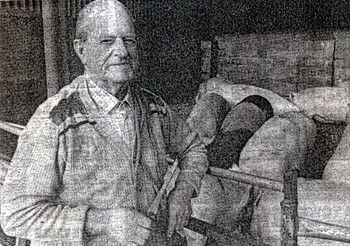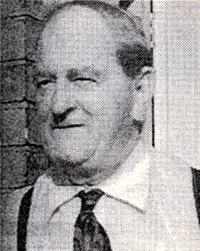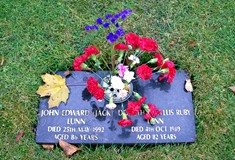|
Killing
the
pig
JACK LUNN
1906-92 |
 |
Providing your own food was a
necessary part of life in rural England in past times and many families,
especially married farm labourers who lived in tied cottages, grew their
own vegetables and reared a pig in the garden to ensure that there was
something to eat during the winter months. Butcher’s meat was expensive
and usually confined to Sunday lunch, even for those who could afford it,
but a pig was a relatively cheap animal to keep, renowned for eating
anything and therefore fed on kitchen scraps and leftovers from the table.
The ritual of killing the pig in the autumn is now part of our social
history, the stuff of many countryside diaries and reminiscences of
boyhood, an occasion when family and friends turned out for the arrival of
the slaughterman and then helped cut and pack the meat, every part of the
animal being used up “except for the squeak” as tradition had it. Dr John
"Alistair" Galletly (1899-1993), who practised as a family doctor in
Bourne for more than 40 years, remembered such an event in his memoirs
when describing a farm worker‘s cottage out in the fen:
Up the back garden path would be a pig sty and
after months of raising the animal came the big occasion of putting away
or killing the pig for food. Every part was utilised. Neighbours would
help, even the women, their blouse sleeves rolled up and wearing a clean
pinny [pinafore]. Saucepans, buckets, pitchers, basins of boiling water
were made ready. Pork pies, pig fry, chitlings, trotters would emerge
whilst the carcass itself would be salted down to be hung up afterwards,
along with sides of bacon.
There are many more similar descriptions
because this was a big village occasion and one man who presided over many
of them was Jack Lunn (1906-1992) who led a varied working life and among
his occupations was that of pig slaughterer, having killed his first pig
in 1920 at the age of 14, thus continuing an old country tradition now
eradicated by the wind of economic change following the Second World War
of 1939-45 and government regulations which decree that all animals are
killed under controlled conditions in a registered abattoir.
Jack, then aged 83 and living at Woodview, Bourne, remembered his unusual
career during an interview with the Stamford Mercury on Friday 29th
December 1989 when he claimed to be the last man in the Bourne area to be
called in to kill the family pig:
I started butchering when I was just fourteen
years old. Then quite by accident I began slaughtering pigs because one
day my boss should have gone but he was ill that he asked me to go
instead. When I got there, the farmer asked ‘What have you come for?’ and
when I told him he said ‘The bloody pig will eat you’ but I soon set about
the job and afterwards he said that he had never seen a pig killed so
fast. That started it all and after that there was no turning back and I soon became very good and it became a very good earner indeed.
Eventually, I was handling some really giant animals weighing as much as
40 stones but by then I was as strong as an ox and could despatch them in
next to no time. In a good year, I could handle at least 80 pigs.
Jack retired from butchering when he was 65
but continued killing the odd pig whenever asked until the official
slaughterhouses took over. But despite the nature of his job and having
worked with bacon alive and dead for 70 years, he still enjoyed a few
rashers for breakfast. “Really marvellous”, he told the newspaper with a
gleam in his eye.
|
BIOGRAPHICAL NOTE
John Edward Lunn, always
known as Jack, was born at Bourne in 1906 to John Edwin Lunn and his
wife Mabel. He attended the elementary school in Abbey Road, leaving
at the age of 11 to start a colourful working career, beginning with
his father at the gasworks where one of his first jobs was as gas
lighter with the task of going round the town lighting the street
lamps in the evening and extinguishing them next morning. |
 |
|
He left to work as a labourer at the Hereward
Labour Camp, later training as a lorry driver helping to cart stone
from the quarry at Castle Bytham to create the ridings in Bourne
Wood.
Since a boy, he had also been helping in the butchery trade in his
spare time, mostly slaughtering pigs, and with the outbreak of the
Second World War in 1939, went to work full time at Bourne abattoir
or depot, as it was known locally, then run by T W Mays and Company.
Apart from killing livestock for food and processing, he also made
deliveries to butchers in the town at a time when meat was strictly
rationed. At the war’s end, he became a bus driver with the Delaine
company and Lincolnshire Roadcar and was awarded safe driving
certificates for three successive years from 1945-47.
His final working years were spent as a lorry driver with South
Kesteven District Council, retiring at 65 but working part time
until he was 76 assisting local butchers in Bourne, Manthorpe and
Stamford, and he continued driving his own car until he was 84 when
he still had a clean licence.
Jack was an active member of the St John Ambulance Brigade and had
many hobbies including breeding and showing rabbits and gardening
with a preference for growing dahlias and geraniums. But despite a
working and social life that was wide and varied, he remains best
known as one of Bourne’s last traditional pig killers alongside
Edwin Danby and “Bony” Wells.
He and his wife, Dorothy Phyllis Ruby Lunn, lived at Woodview,
Bourne, for most of their lives, and had two sons and two daughters. |
|
 |
In their final years, they moved to Meadow Close where
Jack's
wife died on 4th October 1989, aged 82, and he died in Stamford
hospital on 25th May 1992, aged 86. Both were cremated and
their ashes buried together in the garden of remembrance at
the town cemetery where a marble plaque records their lives. |
|
See also
Hereward Labour Camp
St John Ambulance Brigade

Go to:
Main Index Villages
Index
|


